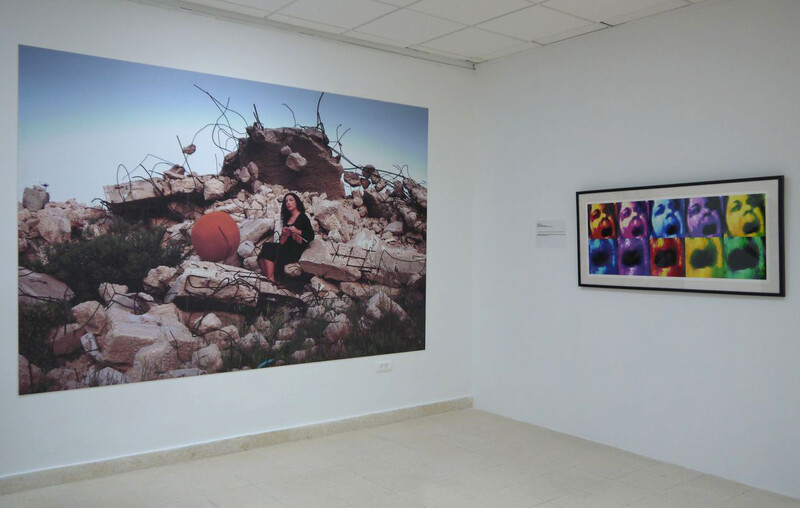The Electronic Intifada Nablus 28 September 2012

Raeda Saadeh’s “Penelope” (2011) and Laila Shawa’s “Scream” (2011).
Framed-Unframed: the Changing Representation of Women in Palestinian Visual Arts explores complex facets of Palestinian feminism, religion and the woman’s role in the liberation struggle. The show is now touring Palestinian universities.
At An-Najah University in the occupied West Bank city of Nablus, where Framed-Unframed shows through Monday, the exhibition begins in the foyer of the fine arts building, where colossal black chiffon dresses hang from a wire strung across the room. The dresses make up Mary Tuma’s “Homes for the Bodiless” (2000), and the vacant female forms they create point to the grief caused by the continued displacement of Palestinians. This theme continues throughout the show.
Equally thematic to the show is the strength of Palestinian women. In An-Najah’s gallery, the show features artwork made in the 1970s, most commonly depicting women as resolute, sturdy symbols of motherhood, nationhood and resistance. Generally made by male artists, the section represents the foundational and ideologically strategic symbolism structured around Palestinian women after 1967.
Defiantly rooted

Mary Tuma’s ”Homes for the Bodiless” installed in the foyer of An-Najah University’s fine arts building.
As the show progresses chronologically, the work is increasingly created by women. The modes of representation become more layered, as in Mona Hatoum’s video piece “Measures of Distance” (1988). Hatoum narrates letters to and from her mother that were sent from Beirut to London; her voice recordings are played over images of Arabic script and images of her mother’s body.
Her mother’s words explain the anger of Mona’s father after he once found them naked, taking photographs of each other in the bathroom. “He was seriously angry. He still nags me about it, as if I had given you something that only belongs to him.”
Extremely personal, the work not only discusses distance and loss, but the relationship of a mother, father and daughter. “Anyway, whatever you do with the pictures, for God sake don’t tell him about it,” the artist narrates.
Waiting for change
Hatoum’s piece is an example of the show’s theme of the female body, a remarkable subject for a show dealing with Palestinian women, but a theme that Palestinian female artists have utilized in bold and thought-provoking ways.
A moving video piece by Jerusalem-based artist Jumana Abboud, “Holding my Breath” (2006), highlights the feelings of suffocation and entrapment caused by the occupation of Palestine. In the piece, the artist stands almost motionless with her head in a bowl or her face hidden behind a curtain. Her body becomes a useless tool as the artist holds her breath and waits for a change.
Inversely, “Wish Tree” by Raeda Saadeh uses the female form as a symbol for hope. This piece involves a video of a performance at Birzeit University as part of the exhibition’s opening ceremony.
In the performance, the artist stands on the campus wearing a white dress with a skirt that extends in a huge circle around her. Saadeh stands with her arms outstretched for three hours while students write wishes on colored pieces of paper and throw them to the “tree.”
Saadeh, based in Jerusalem, is known for using her own body to bring attention to the circumstances of her life and the lives of Palestinians. Also included in the show is her work “Penelope” (2011), a large-scale photograph of the artist sitting atop the rubble of a demolished house, knitting from a giant ball of yarn. A Palestinian version of the character from Homer’s Odyssey, the woman is depicted as patient, persevering through years of hardship.
Lipstick limits?

Amer Shomali’s “The Icon” (2011)
What is the intent behind creating an image of Khaled using make-up? Perhaps it speaks to the limits in representation of Palestinian women based on gender roles, or perhaps it is a statement on consumerism.
Both historical and ideological in different ways, the show touches on a vast number of issues. But by always keeping Palestinian women as its main subject it remains constant. By highlighting their resilience and patience, as well as displaying their grief and sorrow at the continued trials of the occupation, it gives a voice to a dynamic community so often stifled or kept silent.
All images by Daryl Meador.
Daryl Meador is a recent graduate of the School of the Art Institute of Chicago who is currently living and volunteering in Nablus.





